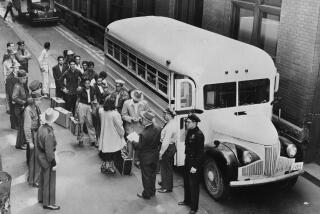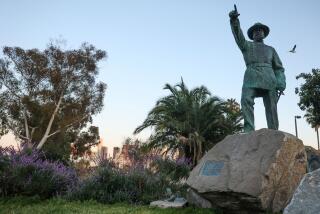Editorial: When the fight to remove statues becomes a struggle against history
Five years after President William McKinley was assassinated at the 1901 Pan-American Exposition in Buffalo, N.Y., farmer George Zehnder presented the Northern California city of Arcata with a 8.5-foot-tall statue of the 25th president. Just a few months before the assassination, Zehnder had met McKinley at an appearance in San Jose, which affirmed his belief that McKinley was the nation’s first modern president and should be honored. Arcata gladly accepted the statue, which was placed in the city’s main square.
Over the last 15 years, though, some folks in and around Arcata — home to Humboldt State University — have come to a different conclusion about McKinley, and today, a debate rages over whether the statue should remain standing or, like so many Confederate statues around the country, be taken down and put in storage. Ultimately, that’s a decision for the people of Arcata, but they ought to think deeply about what criteria they follow in deciding that a statue of a former president is akin to a statue of a Confederate general.
Few American presidents were all good or all bad; few didn’t have failings or make bad choices or even lethal ones.
Statues and monuments in public spaces signal official recognition — and, in most cases, approval — of the memorialized person or event. There are certainly situations in which it is inappropriate to keep them up. Most of the Confederate monuments that have recently been challenged and removed, for instance, glorified a past in which the likes of Jefferson Davis and Robert E. Lee sought to rip the nation apart in defense of slavery. That was traitorous behavior. What’s more, many of the memorials were erected years after the Civil War as a deliberate effort to paint a romanticized “Old South” veneer over the brutal system of slavery, and as hostile signals to African Americans living under Jim Crow laws.
There’s also a movement underway — understandably — to remove blatantly offensive statues and monuments depicting Native Americans, such as the one San Francisco is taking down of a vanquished Native American at the feet of a vaquero and a Spanish missionary. Such statues should be taken down.
But the statue of McKinley, in our view, raises a somewhat more complicated set of questions. McKinley was the last U.S. president to have served in the Union Army. A former Ohio governor, he won the White House in 1896 while the nation was in the throes of a depression, and rode the recovery to reelection in 1900. He led the nation into the Spanish-American War, and its first full steps onto the international stage and into modern imperialism with the takeover of Puerto Rico, Guam and the Philippines.
What’s causing concern now is that McKinley also oversaw federal policies that undercut Native American tribal authority and reduced reservation lands by as much as 90 million acres. Those and related actions led the Tribal Council of the Wiyot Tribe in Northern California to join the campaign to have the statue of McKinley (who had no personal ties to the city) removed. Arcata was built on land seized from the Wiyot Tribe.
This is where the move to un-do historical markers veers into dangerous waters. Were McKinley only known or even best known for objectionable and inhumane policies, there might be a strong argument against the statue. But McKinley stood for much more than that, and a decision on whether to topple his statue ought to embrace the wholeness of his history and impact. Abraham Lincoln, for all that he is revered today, had his own problematic past. Though he claimed to always have opposed slavery, he embraced many of the white supremacist beliefs that predominated in America in his time. He also personally signed off on the hanging of 38 Dakota Indian men convicted of being involved in an uprising in Minnesota. Should we topple statues of Lincoln because of that?
As we have noted, it is ultimately up to the people of Arcata whether McKinley stands or falls. But in our view, a memorial to Robert E. Lee is a symbol of approval for the acts for which he is best known: his efforts to tear the nation apart in an effort to defend the institution of slavery.
It’s not so straightforward with McKinley. Few American presidents were all good or all bad; few didn’t have failings or make bad choices or even lethal ones. McKinley should be viewed in his totality. Except in egregious cases, it makes more sense to educate Americans about their complex, muddled and often unadmirable history than it does to erase or rewrite it.
Follow the Opinion section on Twitter @latimesopinion or Facebook
More to Read
A cure for the common opinion
Get thought-provoking perspectives with our weekly newsletter.
You may occasionally receive promotional content from the Los Angeles Times.










